Strategic Change at Appliances International: Report Analysis
VerifiedAdded on 2022/09/10
|15
|3839
|13
Report
AI Summary
This report provides a comprehensive analysis of managing strategic change at Appliances International (AI) in India. It begins with an internal analysis of AI's strengths and weaknesses, focusing on its global reach and understanding of customer needs, contrasted with poor leadership, communication gaps, and faulty planning. The report also examines external factors using PESTEL and Five Forces analyses, highlighting opportunities in India's growing appliance market and threats from competition and supplier power. It then proposes change interventions, primarily utilizing Lewin's and Kotter's change management models to address communication issues and foster a collaborative environment. The report details the application of these models, including unfreezing, change, and refreezing stages, as well as the role of a change agent. The report also discusses specific strategies such as employee welfare training, interdepartmental meetings, and budget allocation for future plans, ultimately aiming to improve strategic and economic performance. The analysis is based on a case study provided in the assignment brief.
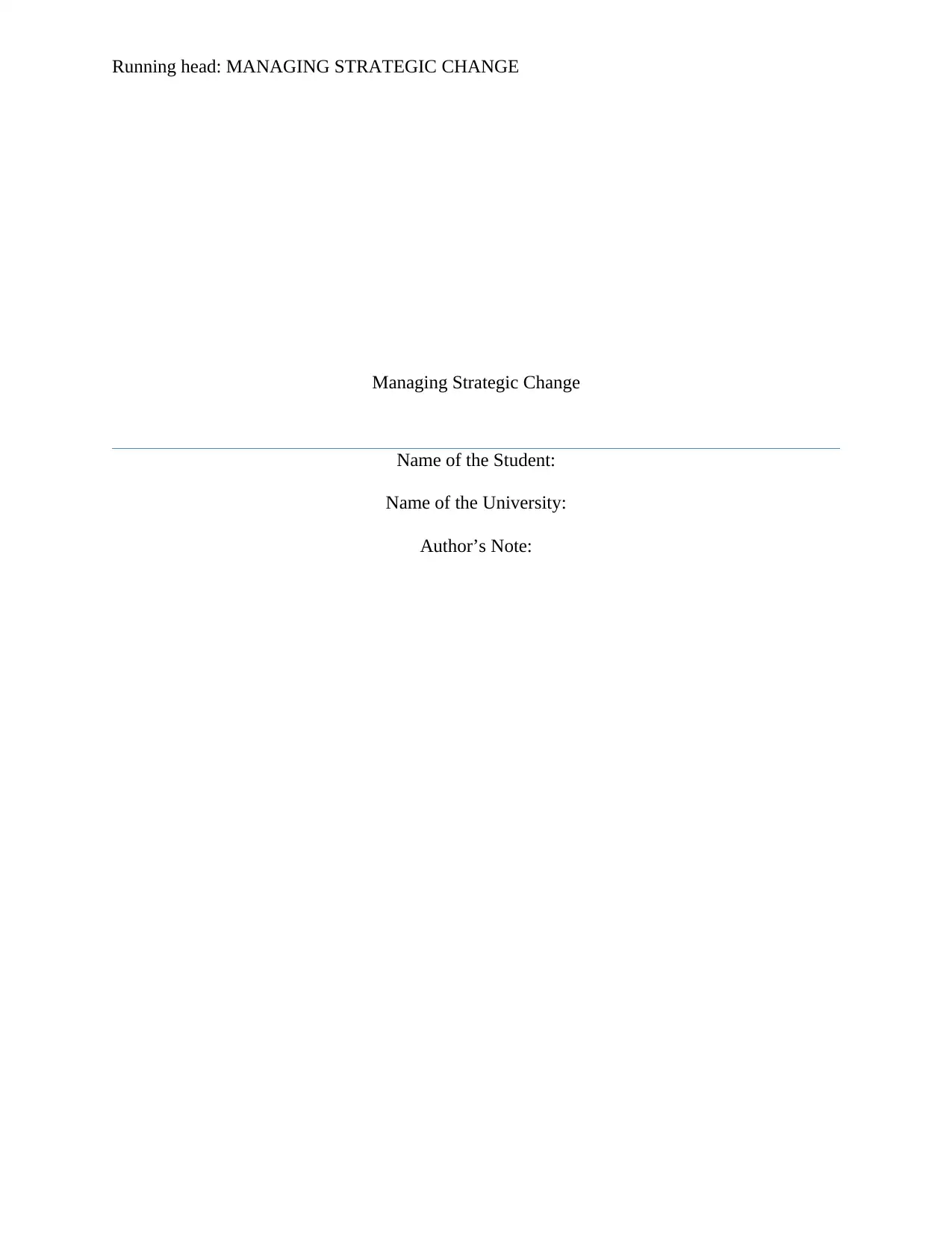
Running head: MANAGING STRATEGIC CHANGE
Managing Strategic Change
Name of the Student:
Name of the University:
Author’s Note:
Managing Strategic Change
Name of the Student:
Name of the University:
Author’s Note:
Paraphrase This Document
Need a fresh take? Get an instant paraphrase of this document with our AI Paraphraser
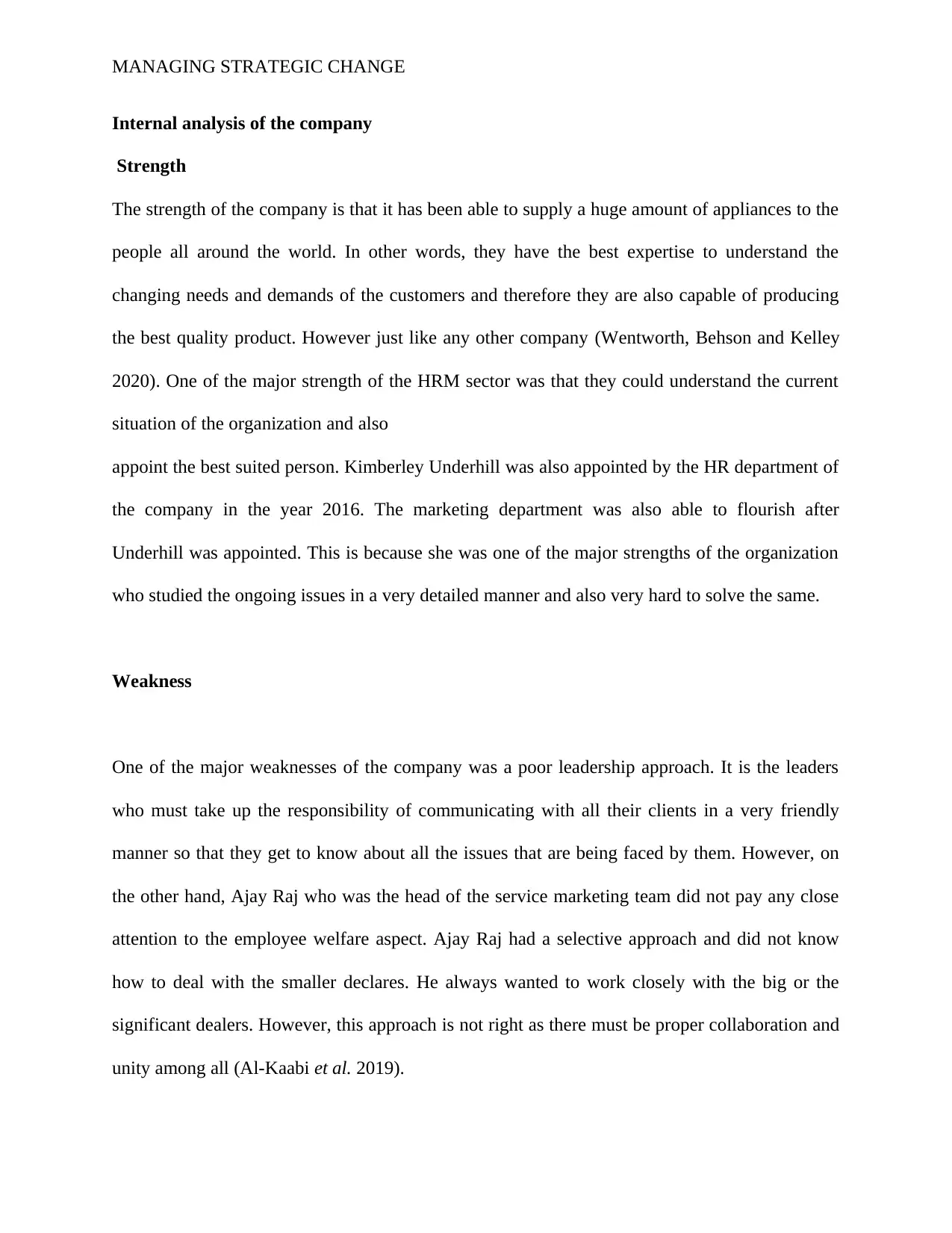
MANAGING STRATEGIC CHANGE
Internal analysis of the company
Strength
The strength of the company is that it has been able to supply a huge amount of appliances to the
people all around the world. In other words, they have the best expertise to understand the
changing needs and demands of the customers and therefore they are also capable of producing
the best quality product. However just like any other company (Wentworth, Behson and Kelley
2020). One of the major strength of the HRM sector was that they could understand the current
situation of the organization and also
appoint the best suited person. Kimberley Underhill was also appointed by the HR department of
the company in the year 2016. The marketing department was also able to flourish after
Underhill was appointed. This is because she was one of the major strengths of the organization
who studied the ongoing issues in a very detailed manner and also very hard to solve the same.
Weakness
One of the major weaknesses of the company was a poor leadership approach. It is the leaders
who must take up the responsibility of communicating with all their clients in a very friendly
manner so that they get to know about all the issues that are being faced by them. However, on
the other hand, Ajay Raj who was the head of the service marketing team did not pay any close
attention to the employee welfare aspect. Ajay Raj had a selective approach and did not know
how to deal with the smaller declares. He always wanted to work closely with the big or the
significant dealers. However, this approach is not right as there must be proper collaboration and
unity among all (Al-Kaabi et al. 2019).
Internal analysis of the company
Strength
The strength of the company is that it has been able to supply a huge amount of appliances to the
people all around the world. In other words, they have the best expertise to understand the
changing needs and demands of the customers and therefore they are also capable of producing
the best quality product. However just like any other company (Wentworth, Behson and Kelley
2020). One of the major strength of the HRM sector was that they could understand the current
situation of the organization and also
appoint the best suited person. Kimberley Underhill was also appointed by the HR department of
the company in the year 2016. The marketing department was also able to flourish after
Underhill was appointed. This is because she was one of the major strengths of the organization
who studied the ongoing issues in a very detailed manner and also very hard to solve the same.
Weakness
One of the major weaknesses of the company was a poor leadership approach. It is the leaders
who must take up the responsibility of communicating with all their clients in a very friendly
manner so that they get to know about all the issues that are being faced by them. However, on
the other hand, Ajay Raj who was the head of the service marketing team did not pay any close
attention to the employee welfare aspect. Ajay Raj had a selective approach and did not know
how to deal with the smaller declares. He always wanted to work closely with the big or the
significant dealers. However, this approach is not right as there must be proper collaboration and
unity among all (Al-Kaabi et al. 2019).
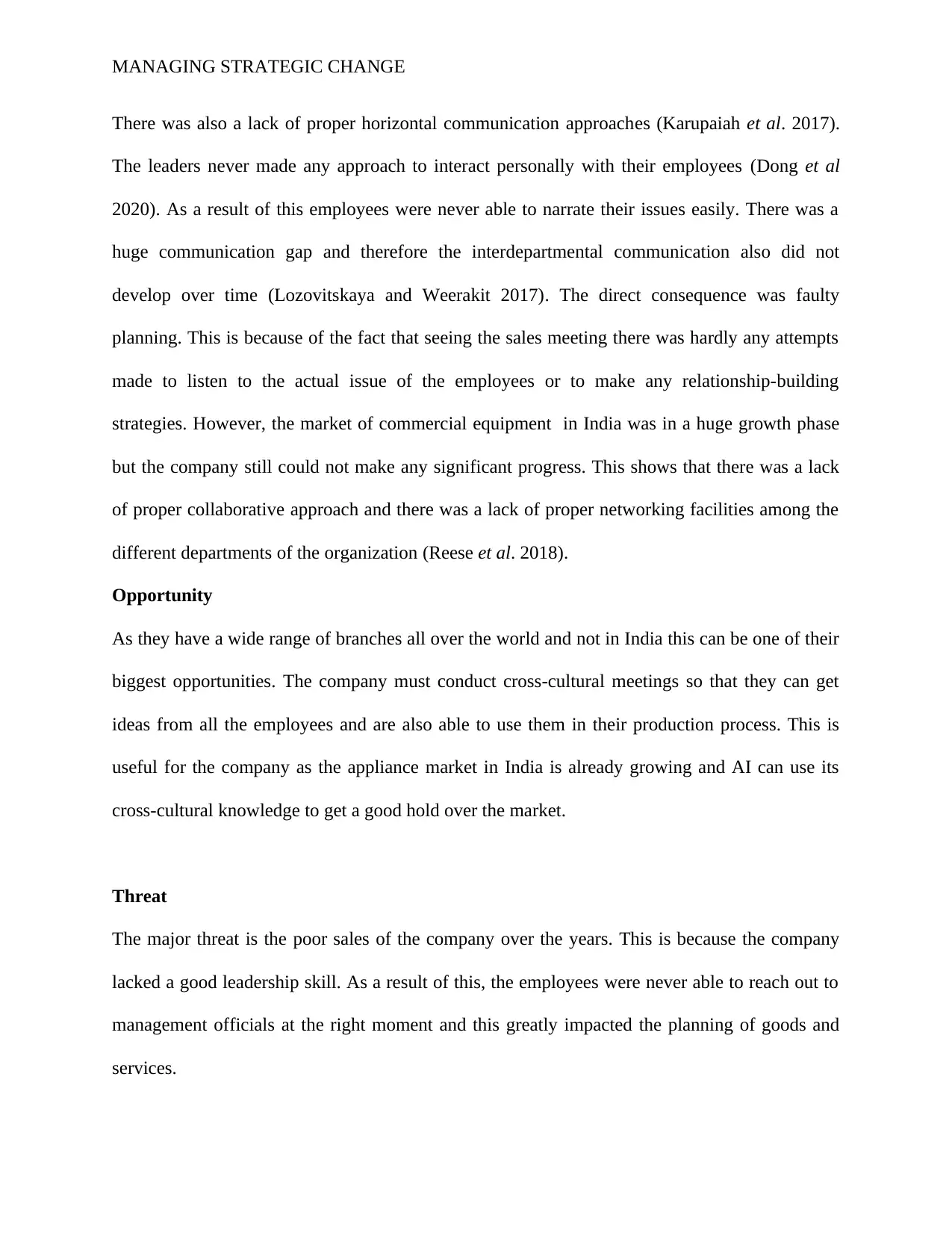
MANAGING STRATEGIC CHANGE
There was also a lack of proper horizontal communication approaches (Karupaiah et al. 2017).
The leaders never made any approach to interact personally with their employees (Dong et al
2020). As a result of this employees were never able to narrate their issues easily. There was a
huge communication gap and therefore the interdepartmental communication also did not
develop over time (Lozovitskaya and Weerakit 2017). The direct consequence was faulty
planning. This is because of the fact that seeing the sales meeting there was hardly any attempts
made to listen to the actual issue of the employees or to make any relationship-building
strategies. However, the market of commercial equipment in India was in a huge growth phase
but the company still could not make any significant progress. This shows that there was a lack
of proper collaborative approach and there was a lack of proper networking facilities among the
different departments of the organization (Reese et al. 2018).
Opportunity
As they have a wide range of branches all over the world and not in India this can be one of their
biggest opportunities. The company must conduct cross-cultural meetings so that they can get
ideas from all the employees and are also able to use them in their production process. This is
useful for the company as the appliance market in India is already growing and AI can use its
cross-cultural knowledge to get a good hold over the market.
Threat
The major threat is the poor sales of the company over the years. This is because the company
lacked a good leadership skill. As a result of this, the employees were never able to reach out to
management officials at the right moment and this greatly impacted the planning of goods and
services.
There was also a lack of proper horizontal communication approaches (Karupaiah et al. 2017).
The leaders never made any approach to interact personally with their employees (Dong et al
2020). As a result of this employees were never able to narrate their issues easily. There was a
huge communication gap and therefore the interdepartmental communication also did not
develop over time (Lozovitskaya and Weerakit 2017). The direct consequence was faulty
planning. This is because of the fact that seeing the sales meeting there was hardly any attempts
made to listen to the actual issue of the employees or to make any relationship-building
strategies. However, the market of commercial equipment in India was in a huge growth phase
but the company still could not make any significant progress. This shows that there was a lack
of proper collaborative approach and there was a lack of proper networking facilities among the
different departments of the organization (Reese et al. 2018).
Opportunity
As they have a wide range of branches all over the world and not in India this can be one of their
biggest opportunities. The company must conduct cross-cultural meetings so that they can get
ideas from all the employees and are also able to use them in their production process. This is
useful for the company as the appliance market in India is already growing and AI can use its
cross-cultural knowledge to get a good hold over the market.
Threat
The major threat is the poor sales of the company over the years. This is because the company
lacked a good leadership skill. As a result of this, the employees were never able to reach out to
management officials at the right moment and this greatly impacted the planning of goods and
services.
⊘ This is a preview!⊘
Do you want full access?
Subscribe today to unlock all pages.

Trusted by 1+ million students worldwide
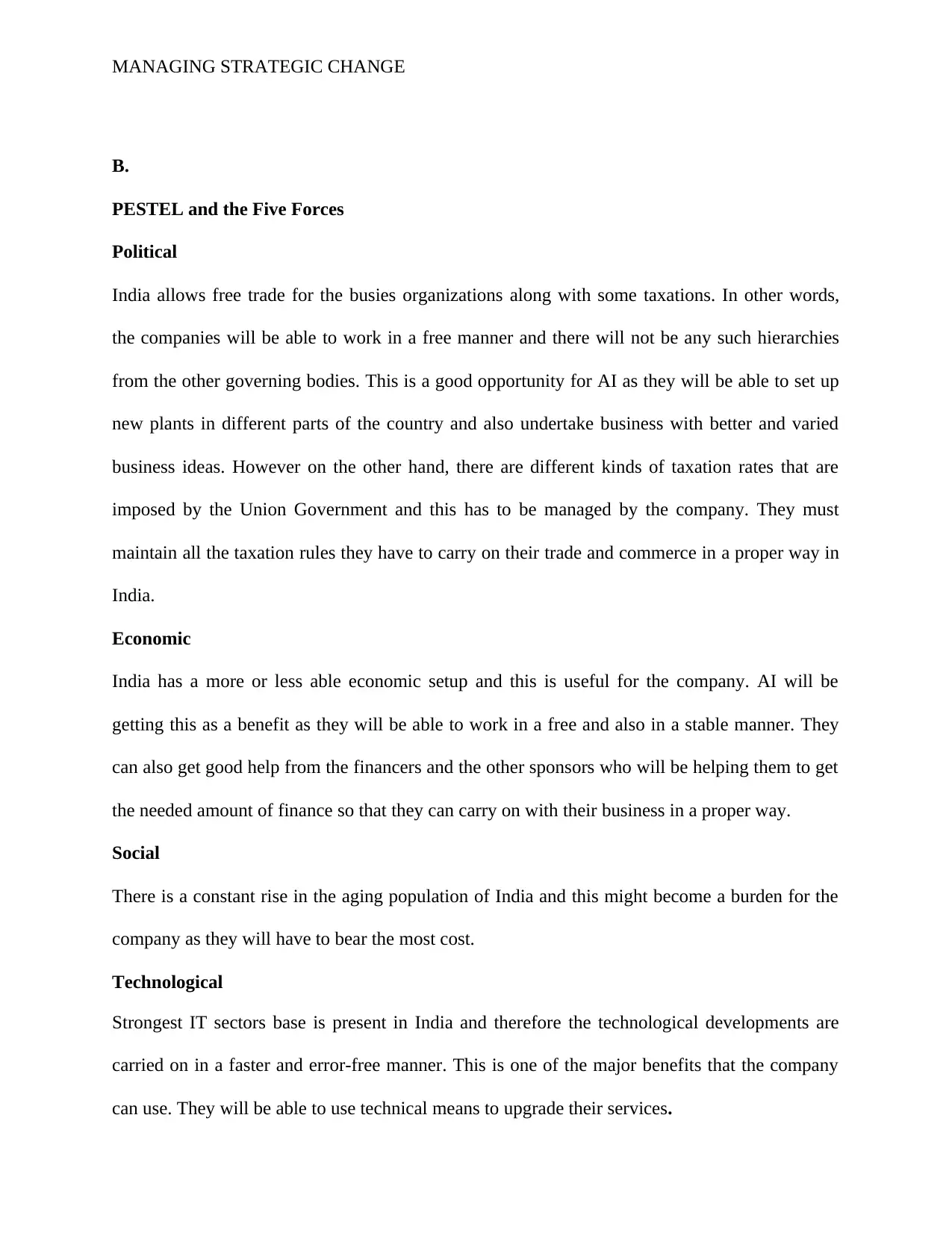
MANAGING STRATEGIC CHANGE
B.
PESTEL and the Five Forces
Political
India allows free trade for the busies organizations along with some taxations. In other words,
the companies will be able to work in a free manner and there will not be any such hierarchies
from the other governing bodies. This is a good opportunity for AI as they will be able to set up
new plants in different parts of the country and also undertake business with better and varied
business ideas. However on the other hand, there are different kinds of taxation rates that are
imposed by the Union Government and this has to be managed by the company. They must
maintain all the taxation rules they have to carry on their trade and commerce in a proper way in
India.
Economic
India has a more or less able economic setup and this is useful for the company. AI will be
getting this as a benefit as they will be able to work in a free and also in a stable manner. They
can also get good help from the financers and the other sponsors who will be helping them to get
the needed amount of finance so that they can carry on with their business in a proper way.
Social
There is a constant rise in the aging population of India and this might become a burden for the
company as they will have to bear the most cost.
Technological
Strongest IT sectors base is present in India and therefore the technological developments are
carried on in a faster and error-free manner. This is one of the major benefits that the company
can use. They will be able to use technical means to upgrade their services.
B.
PESTEL and the Five Forces
Political
India allows free trade for the busies organizations along with some taxations. In other words,
the companies will be able to work in a free manner and there will not be any such hierarchies
from the other governing bodies. This is a good opportunity for AI as they will be able to set up
new plants in different parts of the country and also undertake business with better and varied
business ideas. However on the other hand, there are different kinds of taxation rates that are
imposed by the Union Government and this has to be managed by the company. They must
maintain all the taxation rules they have to carry on their trade and commerce in a proper way in
India.
Economic
India has a more or less able economic setup and this is useful for the company. AI will be
getting this as a benefit as they will be able to work in a free and also in a stable manner. They
can also get good help from the financers and the other sponsors who will be helping them to get
the needed amount of finance so that they can carry on with their business in a proper way.
Social
There is a constant rise in the aging population of India and this might become a burden for the
company as they will have to bear the most cost.
Technological
Strongest IT sectors base is present in India and therefore the technological developments are
carried on in a faster and error-free manner. This is one of the major benefits that the company
can use. They will be able to use technical means to upgrade their services.
Paraphrase This Document
Need a fresh take? Get an instant paraphrase of this document with our AI Paraphraser
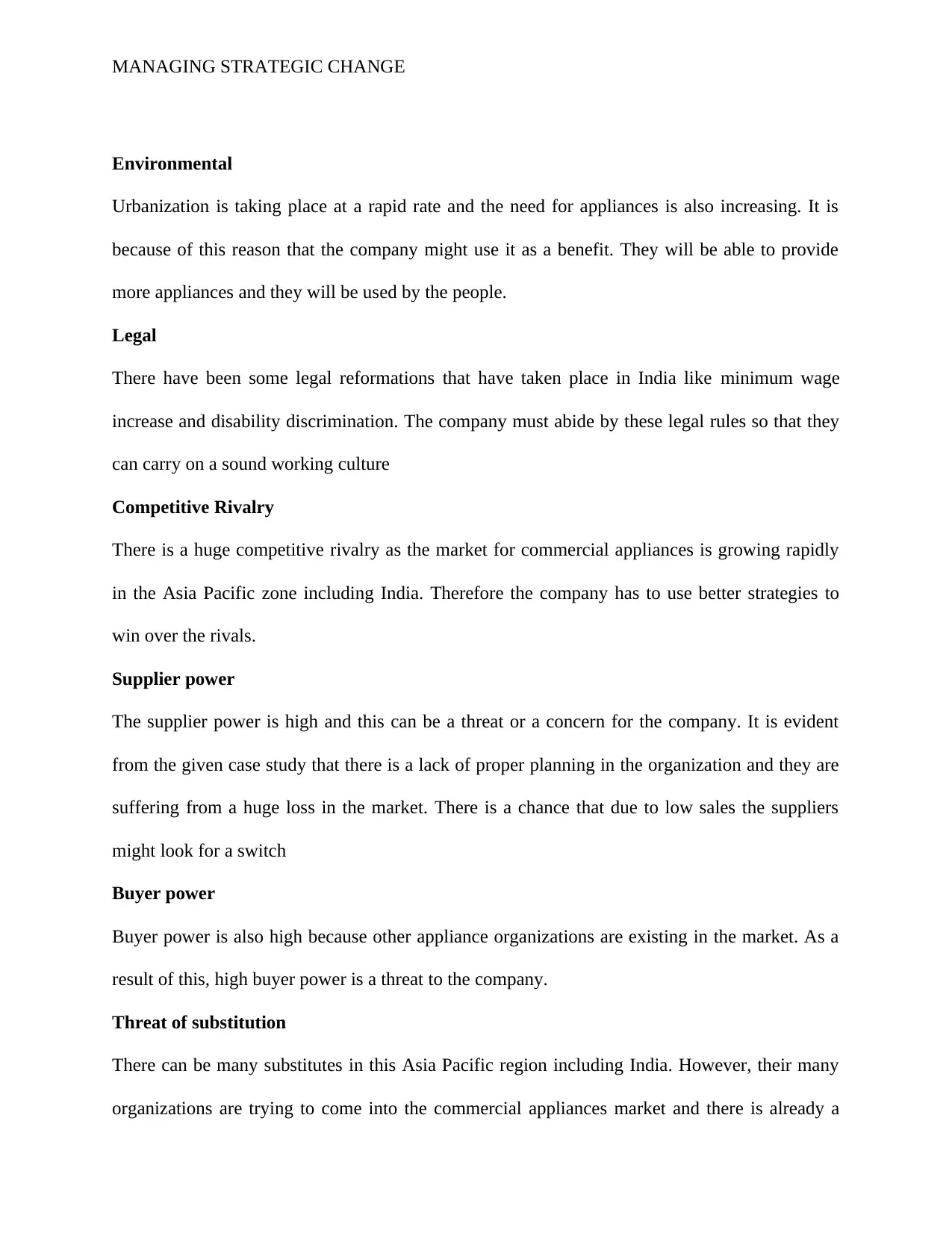
MANAGING STRATEGIC CHANGE
Environmental
Urbanization is taking place at a rapid rate and the need for appliances is also increasing. It is
because of this reason that the company might use it as a benefit. They will be able to provide
more appliances and they will be used by the people.
Legal
There have been some legal reformations that have taken place in India like minimum wage
increase and disability discrimination. The company must abide by these legal rules so that they
can carry on a sound working culture
Competitive Rivalry
There is a huge competitive rivalry as the market for commercial appliances is growing rapidly
in the Asia Pacific zone including India. Therefore the company has to use better strategies to
win over the rivals.
Supplier power
The supplier power is high and this can be a threat or a concern for the company. It is evident
from the given case study that there is a lack of proper planning in the organization and they are
suffering from a huge loss in the market. There is a chance that due to low sales the suppliers
might look for a switch
Buyer power
Buyer power is also high because other appliance organizations are existing in the market. As a
result of this, high buyer power is a threat to the company.
Threat of substitution
There can be many substitutes in this Asia Pacific region including India. However, their many
organizations are trying to come into the commercial appliances market and there is already a
Environmental
Urbanization is taking place at a rapid rate and the need for appliances is also increasing. It is
because of this reason that the company might use it as a benefit. They will be able to provide
more appliances and they will be used by the people.
Legal
There have been some legal reformations that have taken place in India like minimum wage
increase and disability discrimination. The company must abide by these legal rules so that they
can carry on a sound working culture
Competitive Rivalry
There is a huge competitive rivalry as the market for commercial appliances is growing rapidly
in the Asia Pacific zone including India. Therefore the company has to use better strategies to
win over the rivals.
Supplier power
The supplier power is high and this can be a threat or a concern for the company. It is evident
from the given case study that there is a lack of proper planning in the organization and they are
suffering from a huge loss in the market. There is a chance that due to low sales the suppliers
might look for a switch
Buyer power
Buyer power is also high because other appliance organizations are existing in the market. As a
result of this, high buyer power is a threat to the company.
Threat of substitution
There can be many substitutes in this Asia Pacific region including India. However, their many
organizations are trying to come into the commercial appliances market and there is already a
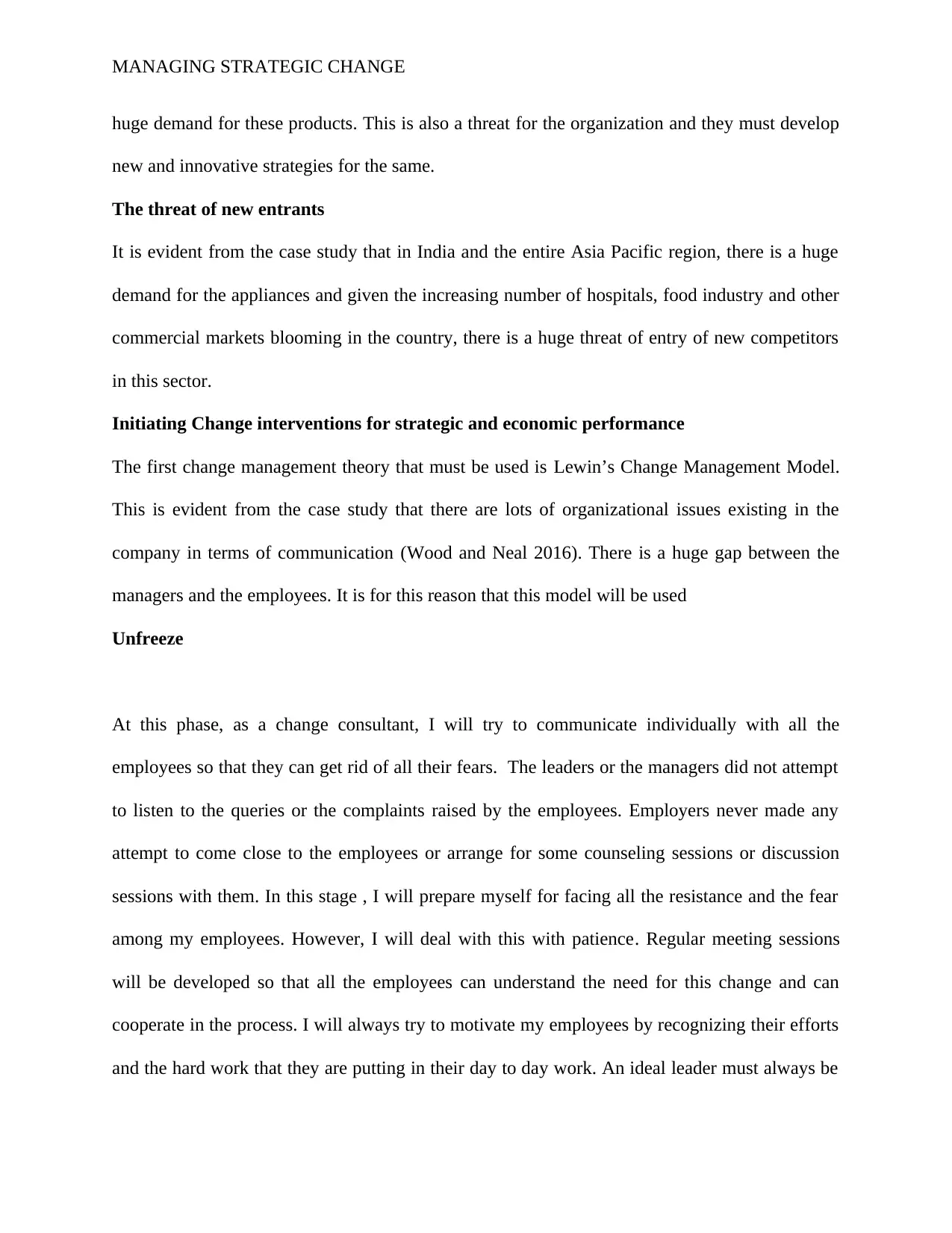
MANAGING STRATEGIC CHANGE
huge demand for these products. This is also a threat for the organization and they must develop
new and innovative strategies for the same.
The threat of new entrants
It is evident from the case study that in India and the entire Asia Pacific region, there is a huge
demand for the appliances and given the increasing number of hospitals, food industry and other
commercial markets blooming in the country, there is a huge threat of entry of new competitors
in this sector.
Initiating Change interventions for strategic and economic performance
The first change management theory that must be used is Lewin’s Change Management Model.
This is evident from the case study that there are lots of organizational issues existing in the
company in terms of communication (Wood and Neal 2016). There is a huge gap between the
managers and the employees. It is for this reason that this model will be used
Unfreeze
At this phase, as a change consultant, I will try to communicate individually with all the
employees so that they can get rid of all their fears. The leaders or the managers did not attempt
to listen to the queries or the complaints raised by the employees. Employers never made any
attempt to come close to the employees or arrange for some counseling sessions or discussion
sessions with them. In this stage , I will prepare myself for facing all the resistance and the fear
among my employees. However, I will deal with this with patience. Regular meeting sessions
will be developed so that all the employees can understand the need for this change and can
cooperate in the process. I will always try to motivate my employees by recognizing their efforts
and the hard work that they are putting in their day to day work. An ideal leader must always be
huge demand for these products. This is also a threat for the organization and they must develop
new and innovative strategies for the same.
The threat of new entrants
It is evident from the case study that in India and the entire Asia Pacific region, there is a huge
demand for the appliances and given the increasing number of hospitals, food industry and other
commercial markets blooming in the country, there is a huge threat of entry of new competitors
in this sector.
Initiating Change interventions for strategic and economic performance
The first change management theory that must be used is Lewin’s Change Management Model.
This is evident from the case study that there are lots of organizational issues existing in the
company in terms of communication (Wood and Neal 2016). There is a huge gap between the
managers and the employees. It is for this reason that this model will be used
Unfreeze
At this phase, as a change consultant, I will try to communicate individually with all the
employees so that they can get rid of all their fears. The leaders or the managers did not attempt
to listen to the queries or the complaints raised by the employees. Employers never made any
attempt to come close to the employees or arrange for some counseling sessions or discussion
sessions with them. In this stage , I will prepare myself for facing all the resistance and the fear
among my employees. However, I will deal with this with patience. Regular meeting sessions
will be developed so that all the employees can understand the need for this change and can
cooperate in the process. I will always try to motivate my employees by recognizing their efforts
and the hard work that they are putting in their day to day work. An ideal leader must always be
⊘ This is a preview!⊘
Do you want full access?
Subscribe today to unlock all pages.

Trusted by 1+ million students worldwide
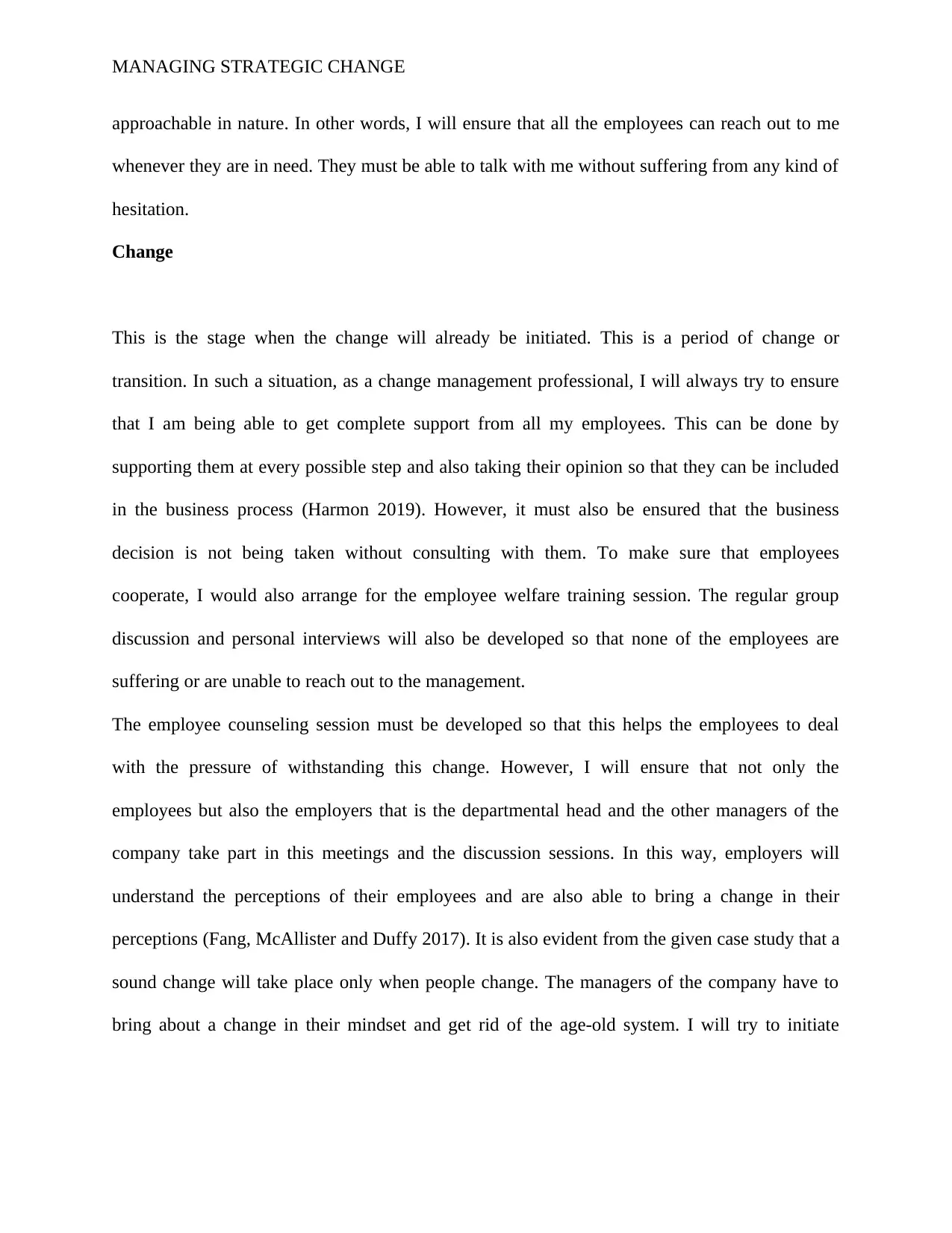
MANAGING STRATEGIC CHANGE
approachable in nature. In other words, I will ensure that all the employees can reach out to me
whenever they are in need. They must be able to talk with me without suffering from any kind of
hesitation.
Change
This is the stage when the change will already be initiated. This is a period of change or
transition. In such a situation, as a change management professional, I will always try to ensure
that I am being able to get complete support from all my employees. This can be done by
supporting them at every possible step and also taking their opinion so that they can be included
in the business process (Harmon 2019). However, it must also be ensured that the business
decision is not being taken without consulting with them. To make sure that employees
cooperate, I would also arrange for the employee welfare training session. The regular group
discussion and personal interviews will also be developed so that none of the employees are
suffering or are unable to reach out to the management.
The employee counseling session must be developed so that this helps the employees to deal
with the pressure of withstanding this change. However, I will ensure that not only the
employees but also the employers that is the departmental head and the other managers of the
company take part in this meetings and the discussion sessions. In this way, employers will
understand the perceptions of their employees and are also able to bring a change in their
perceptions (Fang, McAllister and Duffy 2017). It is also evident from the given case study that a
sound change will take place only when people change. The managers of the company have to
bring about a change in their mindset and get rid of the age-old system. I will try to initiate
approachable in nature. In other words, I will ensure that all the employees can reach out to me
whenever they are in need. They must be able to talk with me without suffering from any kind of
hesitation.
Change
This is the stage when the change will already be initiated. This is a period of change or
transition. In such a situation, as a change management professional, I will always try to ensure
that I am being able to get complete support from all my employees. This can be done by
supporting them at every possible step and also taking their opinion so that they can be included
in the business process (Harmon 2019). However, it must also be ensured that the business
decision is not being taken without consulting with them. To make sure that employees
cooperate, I would also arrange for the employee welfare training session. The regular group
discussion and personal interviews will also be developed so that none of the employees are
suffering or are unable to reach out to the management.
The employee counseling session must be developed so that this helps the employees to deal
with the pressure of withstanding this change. However, I will ensure that not only the
employees but also the employers that is the departmental head and the other managers of the
company take part in this meetings and the discussion sessions. In this way, employers will
understand the perceptions of their employees and are also able to bring a change in their
perceptions (Fang, McAllister and Duffy 2017). It is also evident from the given case study that a
sound change will take place only when people change. The managers of the company have to
bring about a change in their mindset and get rid of the age-old system. I will try to initiate
Paraphrase This Document
Need a fresh take? Get an instant paraphrase of this document with our AI Paraphraser
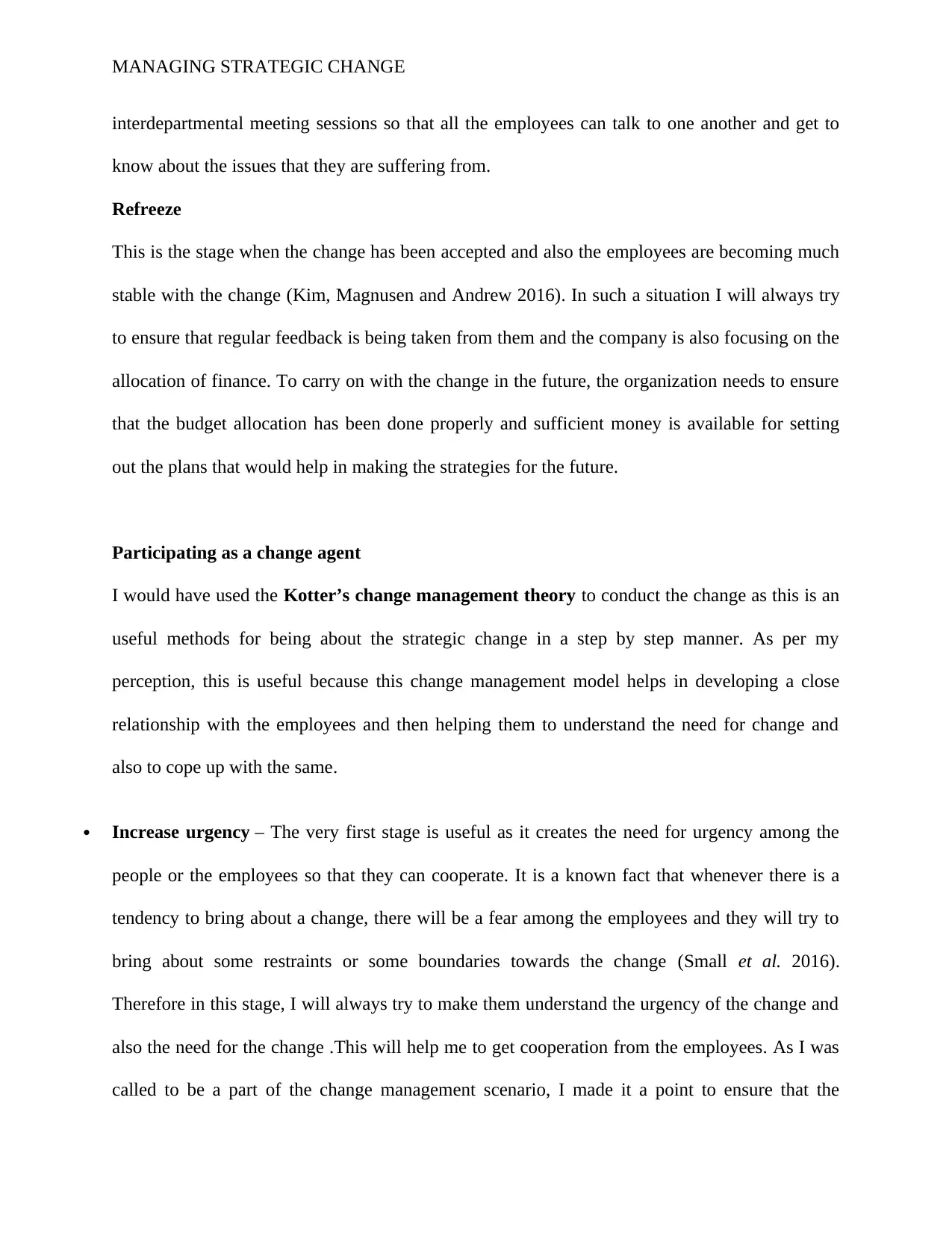
MANAGING STRATEGIC CHANGE
interdepartmental meeting sessions so that all the employees can talk to one another and get to
know about the issues that they are suffering from.
Refreeze
This is the stage when the change has been accepted and also the employees are becoming much
stable with the change (Kim, Magnusen and Andrew 2016). In such a situation I will always try
to ensure that regular feedback is being taken from them and the company is also focusing on the
allocation of finance. To carry on with the change in the future, the organization needs to ensure
that the budget allocation has been done properly and sufficient money is available for setting
out the plans that would help in making the strategies for the future.
Participating as a change agent
I would have used the Kotter’s change management theory to conduct the change as this is an
useful methods for being about the strategic change in a step by step manner. As per my
perception, this is useful because this change management model helps in developing a close
relationship with the employees and then helping them to understand the need for change and
also to cope up with the same.
Increase urgency – The very first stage is useful as it creates the need for urgency among the
people or the employees so that they can cooperate. It is a known fact that whenever there is a
tendency to bring about a change, there will be a fear among the employees and they will try to
bring about some restraints or some boundaries towards the change (Small et al. 2016).
Therefore in this stage, I will always try to make them understand the urgency of the change and
also the need for the change .This will help me to get cooperation from the employees. As I was
called to be a part of the change management scenario, I made it a point to ensure that the
interdepartmental meeting sessions so that all the employees can talk to one another and get to
know about the issues that they are suffering from.
Refreeze
This is the stage when the change has been accepted and also the employees are becoming much
stable with the change (Kim, Magnusen and Andrew 2016). In such a situation I will always try
to ensure that regular feedback is being taken from them and the company is also focusing on the
allocation of finance. To carry on with the change in the future, the organization needs to ensure
that the budget allocation has been done properly and sufficient money is available for setting
out the plans that would help in making the strategies for the future.
Participating as a change agent
I would have used the Kotter’s change management theory to conduct the change as this is an
useful methods for being about the strategic change in a step by step manner. As per my
perception, this is useful because this change management model helps in developing a close
relationship with the employees and then helping them to understand the need for change and
also to cope up with the same.
Increase urgency – The very first stage is useful as it creates the need for urgency among the
people or the employees so that they can cooperate. It is a known fact that whenever there is a
tendency to bring about a change, there will be a fear among the employees and they will try to
bring about some restraints or some boundaries towards the change (Small et al. 2016).
Therefore in this stage, I will always try to make them understand the urgency of the change and
also the need for the change .This will help me to get cooperation from the employees. As I was
called to be a part of the change management scenario, I made it a point to ensure that the
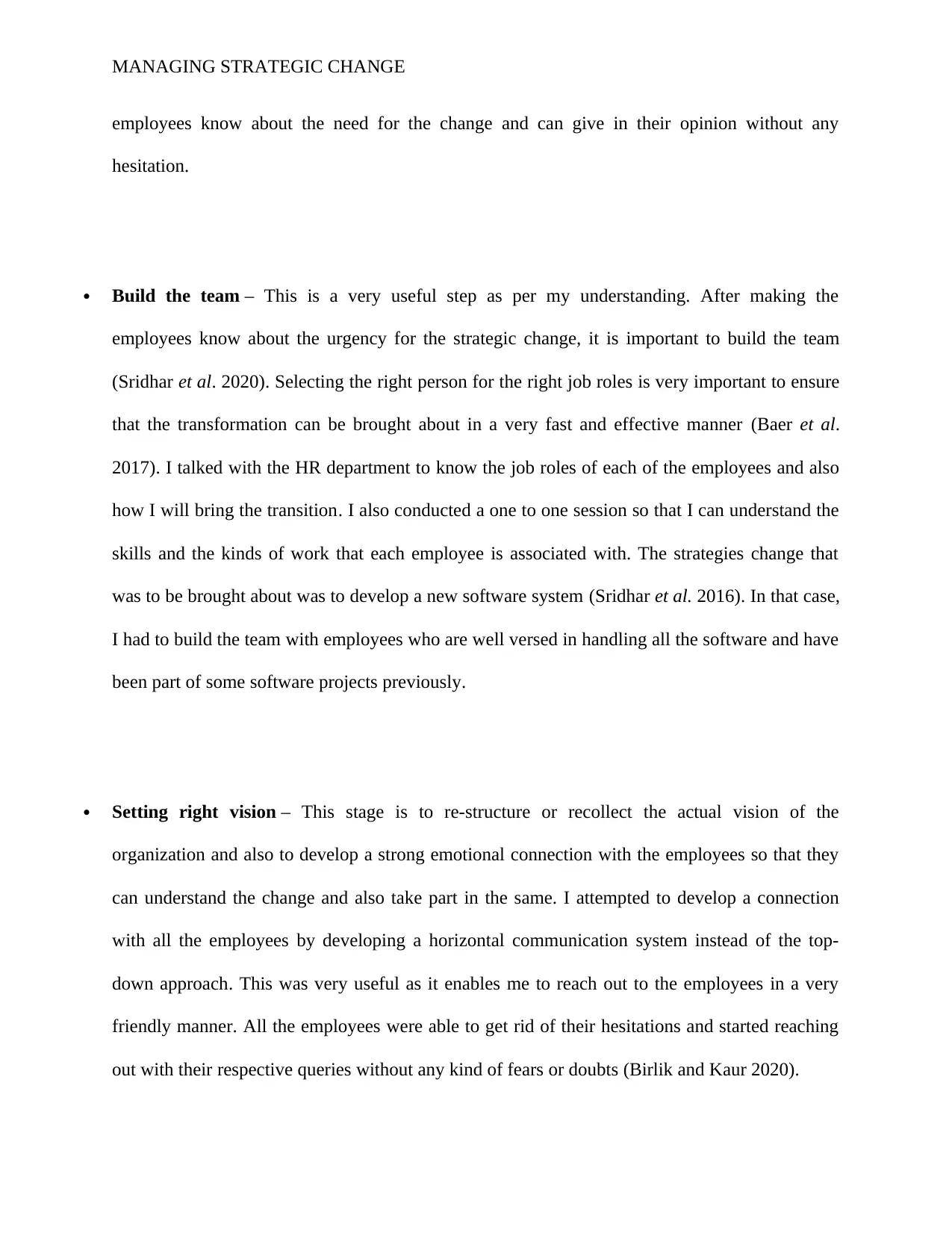
MANAGING STRATEGIC CHANGE
employees know about the need for the change and can give in their opinion without any
hesitation.
Build the team – This is a very useful step as per my understanding. After making the
employees know about the urgency for the strategic change, it is important to build the team
(Sridhar et al. 2020). Selecting the right person for the right job roles is very important to ensure
that the transformation can be brought about in a very fast and effective manner (Baer et al.
2017). I talked with the HR department to know the job roles of each of the employees and also
how I will bring the transition. I also conducted a one to one session so that I can understand the
skills and the kinds of work that each employee is associated with. The strategies change that
was to be brought about was to develop a new software system (Sridhar et al. 2016). In that case,
I had to build the team with employees who are well versed in handling all the software and have
been part of some software projects previously.
Setting right vision – This stage is to re-structure or recollect the actual vision of the
organization and also to develop a strong emotional connection with the employees so that they
can understand the change and also take part in the same. I attempted to develop a connection
with all the employees by developing a horizontal communication system instead of the top-
down approach. This was very useful as it enables me to reach out to the employees in a very
friendly manner. All the employees were able to get rid of their hesitations and started reaching
out with their respective queries without any kind of fears or doubts (Birlik and Kaur 2020).
employees know about the need for the change and can give in their opinion without any
hesitation.
Build the team – This is a very useful step as per my understanding. After making the
employees know about the urgency for the strategic change, it is important to build the team
(Sridhar et al. 2020). Selecting the right person for the right job roles is very important to ensure
that the transformation can be brought about in a very fast and effective manner (Baer et al.
2017). I talked with the HR department to know the job roles of each of the employees and also
how I will bring the transition. I also conducted a one to one session so that I can understand the
skills and the kinds of work that each employee is associated with. The strategies change that
was to be brought about was to develop a new software system (Sridhar et al. 2016). In that case,
I had to build the team with employees who are well versed in handling all the software and have
been part of some software projects previously.
Setting right vision – This stage is to re-structure or recollect the actual vision of the
organization and also to develop a strong emotional connection with the employees so that they
can understand the change and also take part in the same. I attempted to develop a connection
with all the employees by developing a horizontal communication system instead of the top-
down approach. This was very useful as it enables me to reach out to the employees in a very
friendly manner. All the employees were able to get rid of their hesitations and started reaching
out with their respective queries without any kind of fears or doubts (Birlik and Kaur 2020).
⊘ This is a preview!⊘
Do you want full access?
Subscribe today to unlock all pages.

Trusted by 1+ million students worldwide
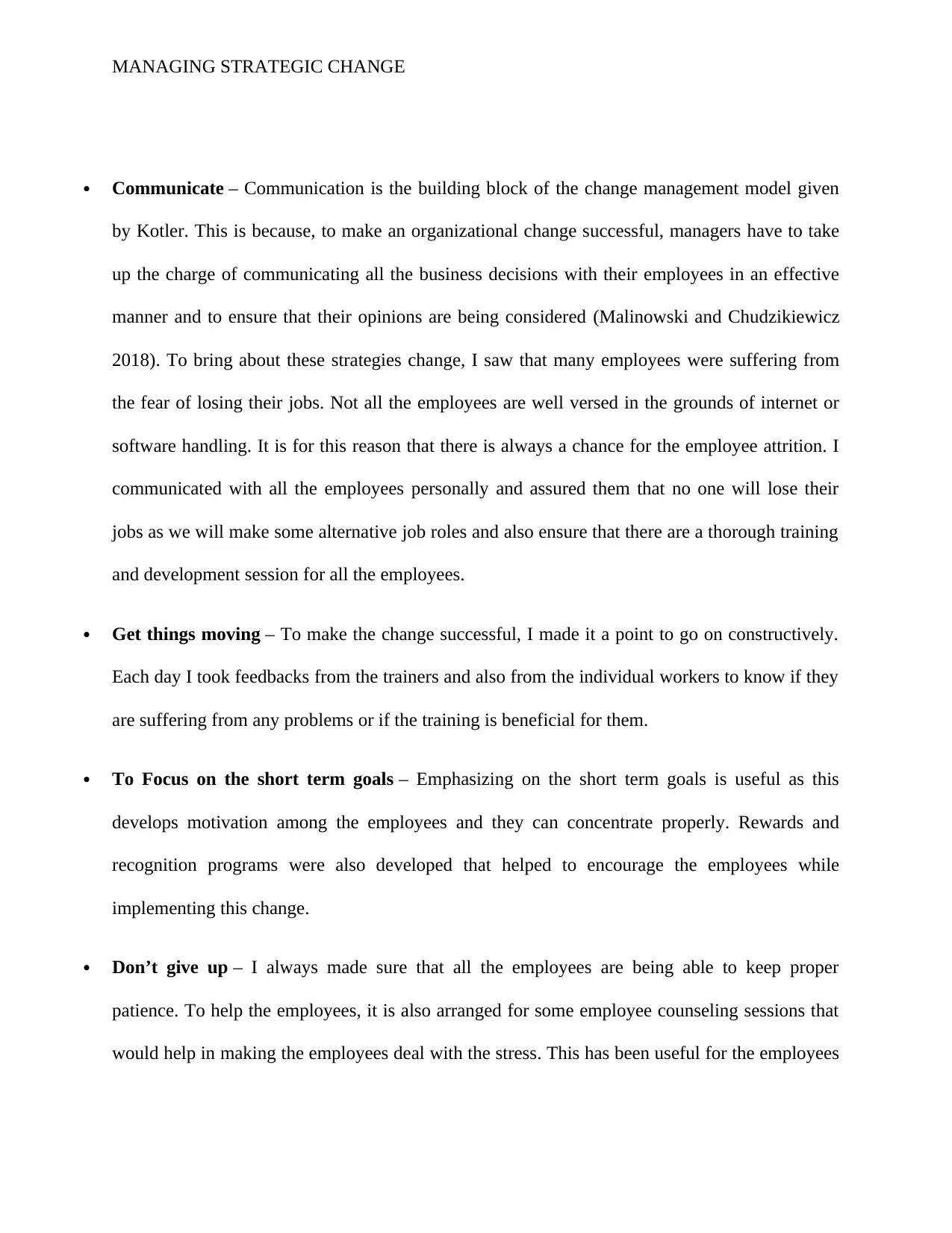
MANAGING STRATEGIC CHANGE
Communicate – Communication is the building block of the change management model given
by Kotler. This is because, to make an organizational change successful, managers have to take
up the charge of communicating all the business decisions with their employees in an effective
manner and to ensure that their opinions are being considered (Malinowski and Chudzikiewicz
2018). To bring about these strategies change, I saw that many employees were suffering from
the fear of losing their jobs. Not all the employees are well versed in the grounds of internet or
software handling. It is for this reason that there is always a chance for the employee attrition. I
communicated with all the employees personally and assured them that no one will lose their
jobs as we will make some alternative job roles and also ensure that there are a thorough training
and development session for all the employees.
Get things moving – To make the change successful, I made it a point to go on constructively.
Each day I took feedbacks from the trainers and also from the individual workers to know if they
are suffering from any problems or if the training is beneficial for them.
To Focus on the short term goals – Emphasizing on the short term goals is useful as this
develops motivation among the employees and they can concentrate properly. Rewards and
recognition programs were also developed that helped to encourage the employees while
implementing this change.
Don’t give up – I always made sure that all the employees are being able to keep proper
patience. To help the employees, it is also arranged for some employee counseling sessions that
would help in making the employees deal with the stress. This has been useful for the employees
Communicate – Communication is the building block of the change management model given
by Kotler. This is because, to make an organizational change successful, managers have to take
up the charge of communicating all the business decisions with their employees in an effective
manner and to ensure that their opinions are being considered (Malinowski and Chudzikiewicz
2018). To bring about these strategies change, I saw that many employees were suffering from
the fear of losing their jobs. Not all the employees are well versed in the grounds of internet or
software handling. It is for this reason that there is always a chance for the employee attrition. I
communicated with all the employees personally and assured them that no one will lose their
jobs as we will make some alternative job roles and also ensure that there are a thorough training
and development session for all the employees.
Get things moving – To make the change successful, I made it a point to go on constructively.
Each day I took feedbacks from the trainers and also from the individual workers to know if they
are suffering from any problems or if the training is beneficial for them.
To Focus on the short term goals – Emphasizing on the short term goals is useful as this
develops motivation among the employees and they can concentrate properly. Rewards and
recognition programs were also developed that helped to encourage the employees while
implementing this change.
Don’t give up – I always made sure that all the employees are being able to keep proper
patience. To help the employees, it is also arranged for some employee counseling sessions that
would help in making the employees deal with the stress. This has been useful for the employees
Paraphrase This Document
Need a fresh take? Get an instant paraphrase of this document with our AI Paraphraser
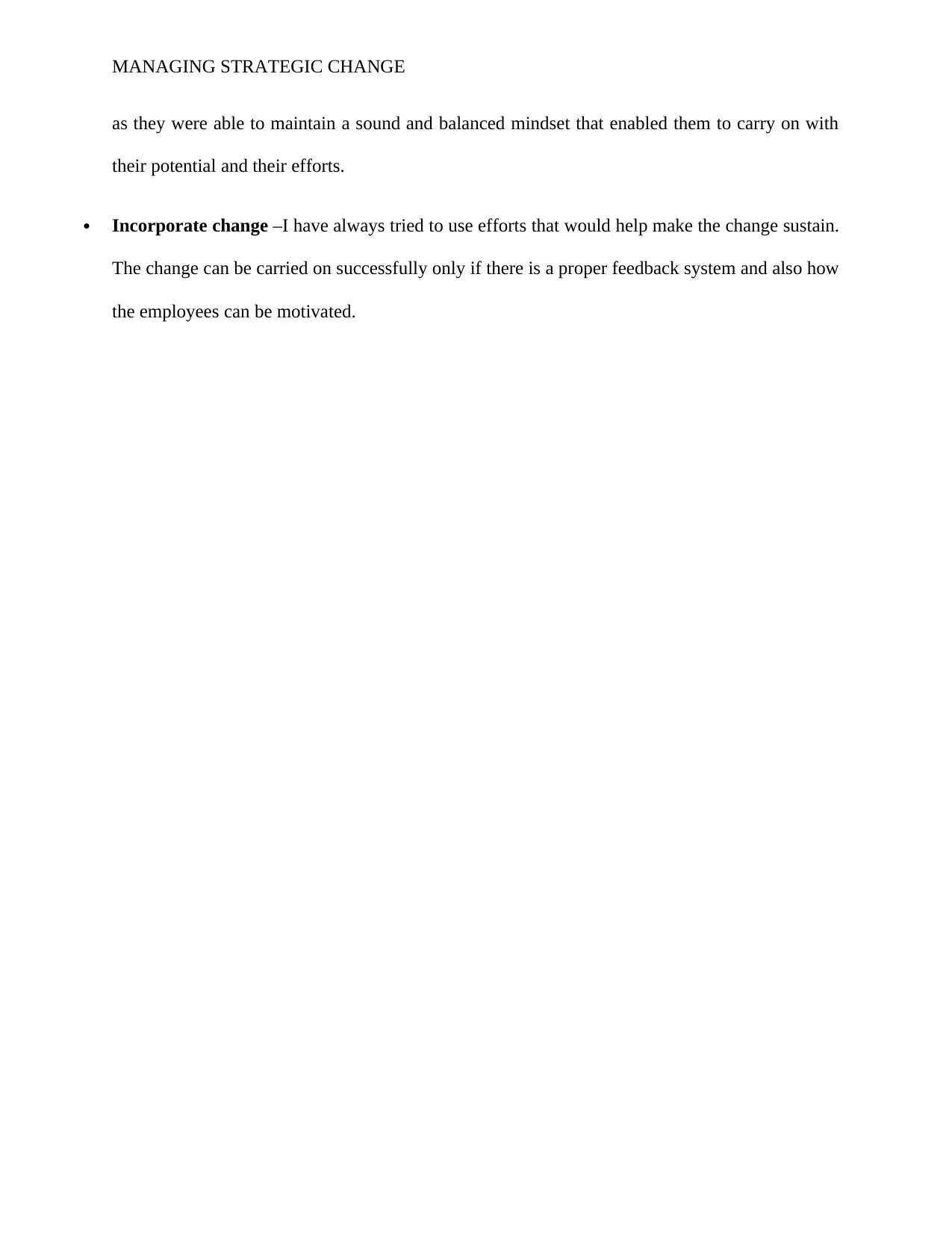
MANAGING STRATEGIC CHANGE
as they were able to maintain a sound and balanced mindset that enabled them to carry on with
their potential and their efforts.
Incorporate change –I have always tried to use efforts that would help make the change sustain.
The change can be carried on successfully only if there is a proper feedback system and also how
the employees can be motivated.
as they were able to maintain a sound and balanced mindset that enabled them to carry on with
their potential and their efforts.
Incorporate change –I have always tried to use efforts that would help make the change sustain.
The change can be carried on successfully only if there is a proper feedback system and also how
the employees can be motivated.
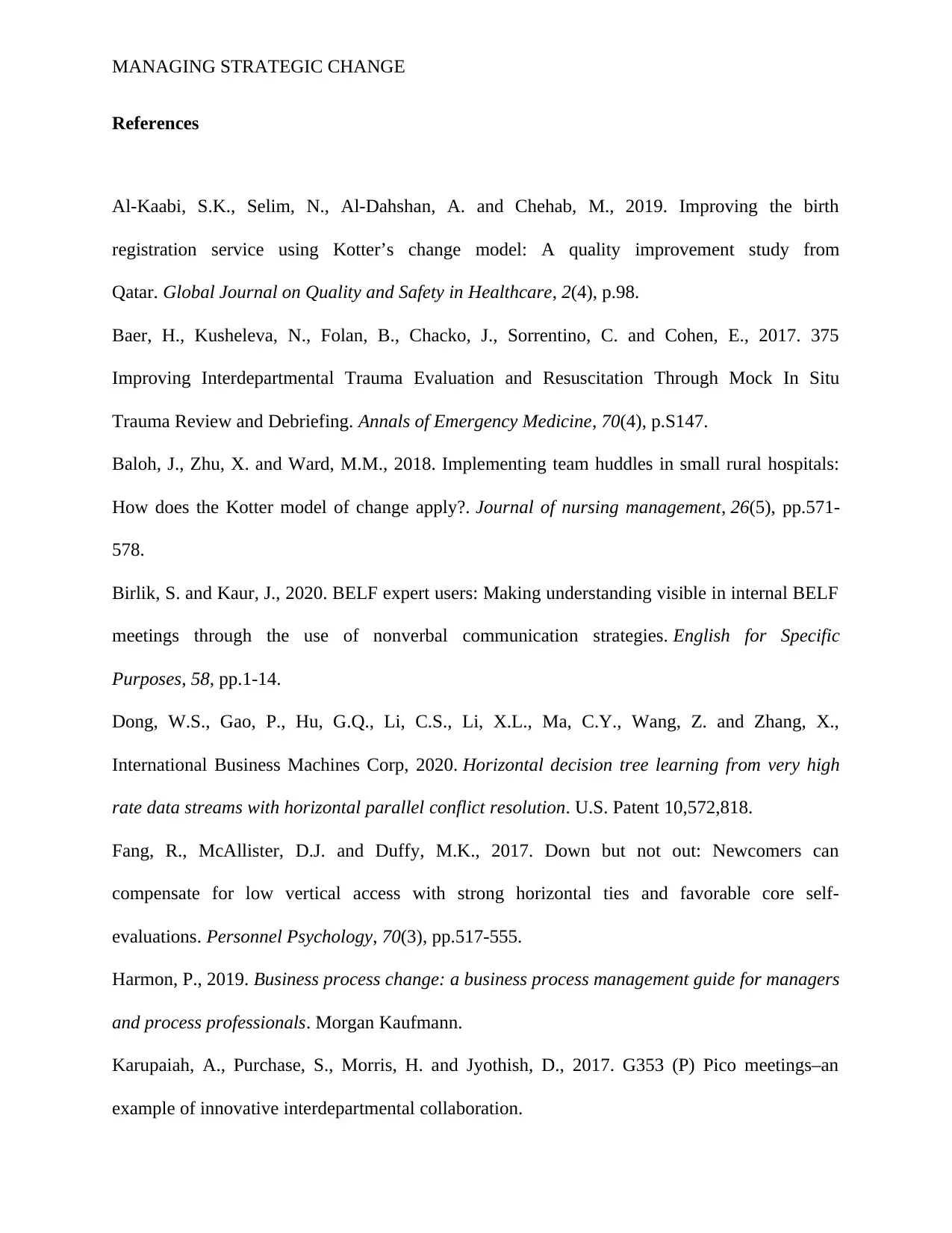
MANAGING STRATEGIC CHANGE
References
Al-Kaabi, S.K., Selim, N., Al-Dahshan, A. and Chehab, M., 2019. Improving the birth
registration service using Kotter’s change model: A quality improvement study from
Qatar. Global Journal on Quality and Safety in Healthcare, 2(4), p.98.
Baer, H., Kusheleva, N., Folan, B., Chacko, J., Sorrentino, C. and Cohen, E., 2017. 375
Improving Interdepartmental Trauma Evaluation and Resuscitation Through Mock In Situ
Trauma Review and Debriefing. Annals of Emergency Medicine, 70(4), p.S147.
Baloh, J., Zhu, X. and Ward, M.M., 2018. Implementing team huddles in small rural hospitals:
How does the Kotter model of change apply?. Journal of nursing management, 26(5), pp.571-
578.
Birlik, S. and Kaur, J., 2020. BELF expert users: Making understanding visible in internal BELF
meetings through the use of nonverbal communication strategies. English for Specific
Purposes, 58, pp.1-14.
Dong, W.S., Gao, P., Hu, G.Q., Li, C.S., Li, X.L., Ma, C.Y., Wang, Z. and Zhang, X.,
International Business Machines Corp, 2020. Horizontal decision tree learning from very high
rate data streams with horizontal parallel conflict resolution. U.S. Patent 10,572,818.
Fang, R., McAllister, D.J. and Duffy, M.K., 2017. Down but not out: Newcomers can
compensate for low vertical access with strong horizontal ties and favorable core self‐
evaluations. Personnel Psychology, 70(3), pp.517-555.
Harmon, P., 2019. Business process change: a business process management guide for managers
and process professionals. Morgan Kaufmann.
Karupaiah, A., Purchase, S., Morris, H. and Jyothish, D., 2017. G353 (P) Pico meetings–an
example of innovative interdepartmental collaboration.
References
Al-Kaabi, S.K., Selim, N., Al-Dahshan, A. and Chehab, M., 2019. Improving the birth
registration service using Kotter’s change model: A quality improvement study from
Qatar. Global Journal on Quality and Safety in Healthcare, 2(4), p.98.
Baer, H., Kusheleva, N., Folan, B., Chacko, J., Sorrentino, C. and Cohen, E., 2017. 375
Improving Interdepartmental Trauma Evaluation and Resuscitation Through Mock In Situ
Trauma Review and Debriefing. Annals of Emergency Medicine, 70(4), p.S147.
Baloh, J., Zhu, X. and Ward, M.M., 2018. Implementing team huddles in small rural hospitals:
How does the Kotter model of change apply?. Journal of nursing management, 26(5), pp.571-
578.
Birlik, S. and Kaur, J., 2020. BELF expert users: Making understanding visible in internal BELF
meetings through the use of nonverbal communication strategies. English for Specific
Purposes, 58, pp.1-14.
Dong, W.S., Gao, P., Hu, G.Q., Li, C.S., Li, X.L., Ma, C.Y., Wang, Z. and Zhang, X.,
International Business Machines Corp, 2020. Horizontal decision tree learning from very high
rate data streams with horizontal parallel conflict resolution. U.S. Patent 10,572,818.
Fang, R., McAllister, D.J. and Duffy, M.K., 2017. Down but not out: Newcomers can
compensate for low vertical access with strong horizontal ties and favorable core self‐
evaluations. Personnel Psychology, 70(3), pp.517-555.
Harmon, P., 2019. Business process change: a business process management guide for managers
and process professionals. Morgan Kaufmann.
Karupaiah, A., Purchase, S., Morris, H. and Jyothish, D., 2017. G353 (P) Pico meetings–an
example of innovative interdepartmental collaboration.
⊘ This is a preview!⊘
Do you want full access?
Subscribe today to unlock all pages.

Trusted by 1+ million students worldwide
1 out of 15
Related Documents
Your All-in-One AI-Powered Toolkit for Academic Success.
+13062052269
info@desklib.com
Available 24*7 on WhatsApp / Email
![[object Object]](/_next/static/media/star-bottom.7253800d.svg)
Unlock your academic potential
Copyright © 2020–2025 A2Z Services. All Rights Reserved. Developed and managed by ZUCOL.





